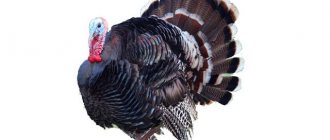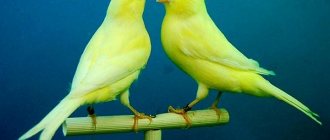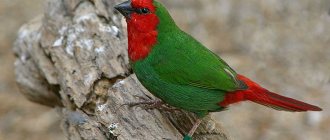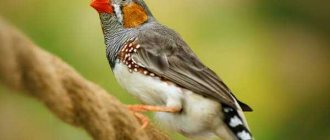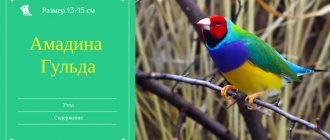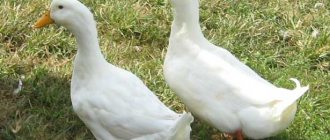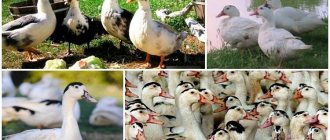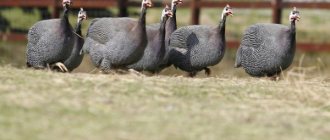Domestic canaries rank second in popularity among poultry after parrots. And this is not surprising: small, friendly and beautiful birds are easy to care for and become a loyal friend to children and the whole family. Some singing canaries have good hearing and can sing beautifully. There are no great difficulties in keeping them at home. It is enough to equip the bird with a comfortable cage, carry out water treatments, walk it and feed it correctly, in a balanced manner. But, like any pet, canaries have both advantages and disadvantages of being kept indoors. We will tell you which ones in detail in the article.
Domestic canary: description, lifestyle, behavior
The domestic canary is perhaps the most popular ornamental bird. She has a pleasant voice and attractive appearance. The small size of the canary made it an ideal bird for keeping at home.
We have collected important characteristics of the bird in this table.
| Length | From 13 to 15 centimeters |
| Wingspan | About twenty-three centimeters. |
| Weight | No more than fifteen grams. |
| Plumage color and external features | There are a huge variety of canary species, differing in appearance. Most often, these birds have red, yellow or orange plumage. |
| Lifespan | The average life expectancy in comfortable conditions can vary from seven to twelve years. |
| Does the bird sing | Pets sing all year round, they become especially active from the end of November until the last days of May. |
Table 1. Characteristics of the canary
The Canary Islands are the homeland of canaries.
The ancestors of the canary were canary bindweeds, native to the Canary Islands, where the name of the bird came from. Canaries still live on the Canary and Azores islands. This area has a warm climate, so birds do not need to fly for the winter.
How to distinguish a canary from a canary?
The gender differences in these birds are quite weak, so sometimes it is really difficult to distinguish a girl from a boy. It is necessary to pay attention to three signs: appearance, sounds made, behavior.
The tail length of females is shorter than that of males by about half a centimeter. In addition, it is necessary to examine the bird’s cloaca. It is advisable to moisten the feathers near it. In boys, the cloaca is shaped, protrudes strongly and ends in a tube with feathers. In females it is located at body level and covered with down.
In addition, females and males make sounds differently. Boys swell their crops when they sing.
How to choose a healthy bird
To purchase a healthy bird that easily adapts to new conditions and will delight you with its singing, you need to be careful.
Important rules:
- cheerful disposition, mobility, vigor;
- shiny, open eyes;
- smooth, close-fitting plumage;
- even breathing, without suspicious sounds - if the bird is worried in your hands, you need to leave it alone, in the cage and look. will her breathing become calm;
- neat paws without growths, spots, scales;
- absence of liquid droppings on the floor of the cage;
- the bird chirps joyfully.
Choosing a canary
Only buying a healthy bird will help you get a friend for yourself who will happily chirp when you see him.
Advantages of parrots
Parrots do not leave a specific smell - miasma (poisonous putrefactive fumes) that can be spread throughout the apartment by other pets: cats, dogs, hamsters.
These birds do not need daily walks outside their native walls. In summer you can take them out in a cage onto the balcony, and in winter you can install ultraviolet lamps for them right in the apartment.
Parrots are considered long-lived; with good treatment and proper care, they will please the owner for a long time.
Each parrot has its own unique charm and personality. Unlike many birds, parrots have certain abilities. They can not only be taught to talk, but also to perform various tricks: dancing, roller skating, bringing or carrying objects to a specified place, and so on.
These birds do not take up much space as they live in small cages. To feed them, you don’t need to buy a lot of food, which saves the family budget. Their main food is a mixture that includes millet grains, millet, flaxseed, canary seed, nuts and other ingredients.
Review of popular types of canaries
Today, many species of canaries are known, they differ in their appearance and singing talents. Let's look at the most popular ones.
Types of canaries:
- hunchback - has a characteristic posture, her head is strongly lowered forward;
- Yorkshire - has a small size, its body resembles a carrot in its shape;
- border - an individual with shiny yellow plumage, does not create difficulties in keeping;
- fife-fancy - resembles the previous type, only has smaller dimensions;
- crested - distinguished by long, slightly raised feathers on the top of the head, forming a fancy crest;
- Norwich is a large individual, has an original appearance and a dense body;
- Staffordshire - a colorful bird whose feathers are colored pink or red;
- lizard - distinguished by speckled colors;
- the Parisian curly-haired is a large bird, its legs are twisted like a corkscrew;
- curly meringer - similar to the previous type, but differs in its small size.
Staffordshire Canary
Such a large number of canary species is due to the desire of breeders to breed the best type of canary, which will delight the owner with melodious trills.
Who are parrots
Parrots are the name given to all birds that belong to the order Parrotidae. There are many species of parrots that share common characteristics:
- body length,
- variety in plumage color,
- a strong beak, with the help of which parrots chop food, climb trees and protect themselves from enemies.
Most species of parrots can remember and reproduce sounds, words, and even entire phrases. This is what they are famous for. However, keeping parrots has its pros and cons.
Where is the best place to buy a canary?
Buying a canary
To think about keeping canaries at home, you first need to purchase a bird. Where is the best place to buy it, we will look at it in the table.
| Where to buy poultry | pros | Minuses | Peculiarities |
| Pet Shop | Checking animals for diseases and parasites; wide choose. | There is a possibility that the bird has other diseases; minimal care for birds; poor feeding; living in overcrowded cages; sedentary lifestyle. | It is necessary to carefully inspect the bird before purchasing. |
| Nursery | Responsible attitude towards the health of birds sold; provides information about the advantages and disadvantages of the pet; the opportunity to acquire an excellent singer. | High price for birds. | You should not go to the first address you come across on the Internet; it is better to collect more information about the nursery and find reviews from real customers. |
| Private owner | Low prices for birds. | High probability of acquiring a sick pet; possibility of purchasing a wild pet. | If you are dealing with a decent seller, you will see bird food and a carrier. Such a person will always leave you a phone number so that you can call him with any questions you may have. |
Table 2. Places to purchase canaries
Keeping canaries in pairs
Useful tips before purchasing:
- buy one bird if you have time to keep it company, otherwise, take a couple;
- if you want a beautiful bird, you can choose a female; if you want melodious singing, choose a male;
- Buy a bird no earlier than it is six months old.
Do not forget to visually inspect the bird before purchasing; it should look healthy.
Canary: proper care for a songbird
Caring for and maintaining a canary at home is disproportionately simple relative to the aesthetic pleasure that the bird gives to the owner. Modern finches look very different from their wild ancestors. Yes, and human singing abilities have been subjected to selection. So in any store you have an improved version of the colored singer. Cute and familiar small fry - what's there to deal with a canary? But which other bird has a separate competition for singing a song? In addition, specialists closely monitor the purity of the breed. Or maybe they are protecting the canary for a reason? Let's figure it out.
How to care for a canary at home?
Some of the most popular pet birds are parrots, but the hundreds of members of the canary genus will confuse anyone who wants to classify them. In all this variety of variegation, body and voice features, the World Ornithologists Union identifies the following types of canaries:
- singing breed;
- color group;
- decorative appearance;
- hybrid representatives.
Photo of a canary
All males sing, so why separate the singing species separately? The fact is that trill trills are different. Colored and decorative representatives cope with this task not so masterfully. Singing canaries have a richer arsenal of conquered octaves and a wider range of sounds. The human ear perceives her singing as melodious, since this vocalization has been practiced by more than one generation of breeders. Connoisseurs of the breed constantly select the best representatives. There is no other way, because this is a stabilizing factor.
Pedigree characteristics of singers include vocal tonality, performance in a certain manner, and wide range of knees. Colored people have different characteristics: wide range of colors, uniform color distribution, overall harmony. Figured (decorative) to match the breed requires: extravagance of plumage, unusual constitution. All these parameters are recorded, because they are the ones that will be passed on to the next generation of birds.
Singing ability is carefully guarded. For example, in order to get away from the trills of siskin sounds, breeders had to cross different breeds of songbirds for many years. Also, experimenters put a lot of effort before the appearance of canaries with curls, small Yorkshires, and Norwiches. Hybrid birds are also successfully bred in canary breeding. Each specific experiment has its own goal of obtaining new characteristics. But in all of them, resilience is a prerequisite.
How many years do canaries live? If you properly care for them, then 10 years. A significant role in this is played by the competent selection of the size of the canary cage. A rectangular dwelling with a length of 40 cm, a width of 25 cm, and a height of 30 cm is considered suitable. In addition to the drinking bowl, feeder and perch, be sure to place a bathing suit in it. This will give your winged pet a lot of pleasure. Make sure there are no drafts, because they are unacceptable for a gentle voice.
The natural seasonal change in plumage in canaries is called molting. If you maintain your pet correctly, then this process goes smoothly and bald spots do not form on the bird’s body. However, it will immediately react to a lack of minerals, vitamins and amino acids with improper feather formation. It is enough to introduce the missing component into the diet and the balance will be restored.
What to feed canaries at home?
What do canaries usually eat? They, it must be admitted, are not picky. They peck at the grain and sing. One individual eats 2 teaspoons of food per day. No more, otherwise the bird may be overweight, and in flying this is like death.
It is recommended to have three feeders in the cage, because all food for canaries is divided according to its composition into grain, mineral, and soft.
Mineral feeding will be ordinary eggshells, charcoal or settled mineral water. Remember that the shells must be boiled and dried for 5 minutes before crushing. Good vitamins include dandelion leaves, sorrel, lettuce, young nettles, grated carrots, and apples. Dried herbs, fruits and vegetables are suitable for winter vitaminization. Just don't overdo it with portions - you need a very small amount.
Colored canaries
Depending on what canaries eat, their mating periods can be regulated. By gradually adding sprouted grains to their diet, you are giving them a signal - it's time to get active. The scheme is as follows: the first two weeks, a teaspoon, then this portion every week, then every day.
Breeding canaries at home for beginners
In order to competently carry out the process of breeding canaries, we will not rush. It's an important matter! There are two schemes for this:
- create a permanent pair in one cell;
- contain several females in different cages, and the same male alternately visits them.
In these configurations, the canary always has one “husband”. There is also an option in which many birds live in a large aviary at once, and they may not be of the same species. However, access to birds in this case will be difficult, so breeding canaries at home is not preferable.
Most often, under natural conditions, a brood is born in the spring. It is at this time that daylight hours increase, and plenty of food appears in the air and on the ground. But at home, three-year-old birds can be forced to breed at any time. To do this, first of all, you will need a canary nest, which you can make with your own hands. It is made from burlap threads, rope with a diameter of up to 2 mm, or from large rope. A cone-shaped product up to 9 cm deep and up to 11 cm in diameter is woven or glued together. Having installed it in the middle of one of the walls, they increase the lighting and introduce complementary foods.
It is difficult to measure exactly how long a canary incubates eggs, since each of them appears in the nest on different days. That's why chicks don't appear on the same day. After a week or 10 days, the first one is laid in the nest, then one additional is added every day, and so on until 6. The female will incubate them for 2 weeks.
Newborn chicks are all similar, but how can you tell an adult canary from a canary? Only by the presence of three signs at the same time:
- External . The female has a shorter tail. Also, the shape of the male cloaca has a convex cylindrical shape.
- Singing . In the female it is quiet and monotonous. The male's repertoire is extensive and loud.
- Behavioral . The female behaves submissively, the male breaks away. The kenar does not actively build a nest.
Knowing these features, you can easily select a couple of pets.
Photo of canary and canary
It is very interesting to listen to how the canary sings. The tonality of their trill is emotionally close to a person, relaxes and sets the mood for positivity. Maybe because the kenar’s song is old, he learned it from his father, and he from his. But they are loved not only for this - colorful feathers are pleasing to the eye. The flights of imagination of canary breeders are high, they select birds and breed new breeds whose plumage is more beautiful than the previous ones and whose voice is sweeter.
Canaries are so loved that they have created support funds and bird clubs, which have terabytes of recordings of canary trills and many portfolios. It’s time to open conservatories for these feathered vocalists, because singing competitions are constantly being held for them. Here you have an ordinary bird, but how serious everything is!
The most common mistakes in keeping canaries
To ensure that owning canaries brings you only pleasant emotions, pay attention to the mistakes that inexperienced owners often make.
Fresh vegetables in the diet of canaries
Common mistakes:
- mating of closely related individuals;
- feeding birds only purchased food - their diet should contain greens, fresh fruits and vegetables;
- ignoring mineral supplements - they are necessary for the healthy development of birds.
In order for a canary to grow healthy, you need to strictly monitor its diet and properly care for the bird. If you have any concerns, it is better to seek advice from a specialist.
When the owner of the cage is a parrot
Some parrots are friendly towards other birds and will be able to let them into their home. For example, budgies have an easygoing character. Especially if settlement occurred at an early age, the chicks can more easily tolerate such a neighborhood.
Still, you shouldn’t add a canary to a parrot. If you come across a cocky or aggressive parrot, it will begin to peck at its calm neighbor and pull out his feathers. If the canary turns out to be smaller in size, it risks dying from the paws of a larger bird.
If a parrot lived alone for a long time and received all the attention from its owner, it will be difficult for it to accept a stranger, especially in its own cage. Typically, solitary birds have a highly developed sense of ownership. They consider their cage a refuge where they can feel safe.
Content Features
Proper care of the kenar will extend its life, reducing the risk of disease.
Bathing
Canaries love to swim. For this purpose, a bathing suit is provided - a container made of plastic or glass. The bathtub is only half filled with water, otherwise the bird will drown. Suspended on an open door or placed on a pallet. In summer they put it once a day, and in winter - twice a week. While the female is incubating chicks, do not place a bath, otherwise there is a risk of death of both the adult and the offspring.
Nail trimming
The bird's claws should be strong and sharp. Otherwise, she will feel discomfort and will not be able to cling to the swing. The tips of the claws are cut off with tongs or manicure scissors to a maximum of a couple of millimeters. If you cut harder, there is a risk of a wound.
Cleaning the cage
Canaries are big purists. They often preen themselves, preen their feathers, and comb their hair. In a dirty cage, birds will become restless and will hit the walls, losing their feathers to the stumps. They may also stop singing.
By following simple recommendations, you will avoid problems:
- Feeders and drinkers are washed, wiped dry with a cloth and scalded with boiling water whenever food or drink is changed.
- It is necessary to check whether harmful mucus has appeared on the walls of the dishes.
- The water is changed at least a couple of times a day.
- For swimming, take only clean water.
- The poles and swings are washed in hot water, cleaned of droppings, and doused with boiling water.
- The cage is washed at least once a week. At the same time, canaries can fly around the room. All contents are first removed from the cell. After brushing, rinse the walls and pour boiling water over the trays.
- The canary can be returned only after the cage is completely dry.
Feather Trimming
If necessary, birds' wings are clipped. The goal is to prevent the bird from flying quickly. Trimming does not completely deprive the bird of the ability to fly, but only reduces the speed and range of flight. Trimming is done on only one of the wings. The procedure is carried out carefully so as not to damage the skin.
Flying
Birds need to fly around the room. This makes the birds healthy and promotes voice development. In a cramped cage, the canary only sleeps, bathes and rests from its owner. Most of the time the pet can fly around the room. Close all windows and doors, remove the cat, and keep an eye on the bird.
Shedding
Molting is a painful state of changing feathers, so during this period your pet needs increased attention. In terms of timing, the molting period runs from August to September. Move the bird to a sunny place without direct sunlight and increase feeding.
Problems in the breeding process
But still, breeding is a complex process. And certain difficulties can always arise
Diseases
One of the main problems is tick infestation. Some types of parasites are not dangerous for adult birds, but can kill chicks. The birds become weaker, often preen their feathers, and generally behave restlessly. It is advisable to invite a specialist to examine the birds. The optimal treatment is to treat the feathers with insecticides.
A common disease known as legenot is that a canary lays eggs without a shell. Of course, she will not be able to reproduce. Usually occurs due to a lack of minerals in the body. In addition, you need to increase the temperature in the room and treat the female's cloaca with oil.
How to tame
In order for the canary to stop being afraid, in addition to your hands, it is important to accustom the canary to the sound of your voice,
A solitary canary is the easiest to train, and it is easier to establish contact with a male than with a female. The main thing in the taming process is not to rush. Every day you need to approach the cage with the bird and talk to it in a quiet, calm voice. She needs to be given time to get used to it and believe that she has nothing to fear.
The second stage of the taming process should be placing the bird on the palm. This needs to be stimulated by feeding. Having become comfortable and accustomed to the person, she will do this without fear.
Preparation
You need to prepare for the appearance of a motley warbler at home:
- If the family already has a cat, then buying a new pet is a big question. It is unlikely that they will become friends; most likely, the cat will begin to hunt the bird;
- all family members should not be allergic to bird feathers;
- if you notice gaps between the wall and the cabinet, then rearrange it, or cover the gap with improvised materials: newspapers, rags, foam rubber;
- reconsider indoor plants, because some of them may be dangerous for birds;
- All windows must have mosquito nets.
Reproduction
Obtaining healthy offspring requires compliance with certain rules:
- The optimal time for mating is spring. At this time, there is a long daylight hours, and the female feeds the cubs much more.
- Choose a male for mating that is large, handsome, active, and also with a good voice. His age is at least 1 year. The female must also be beautiful and healthy.
- Both parents influence the color of the future young, but only the father influences the voice.
- Partners are placed in cages opposite each other for a day so that they look at each other and become interested. After that, they are placed together: the male is allowed into the common cage first, and after a day or two, the “lady”. Mating occurs quickly, and the female begins to build a nest. The period from mating to the laying of the first eggs is 3–10 days.
- To make nest construction comfortable, place small pieces of natural fabrics, cut cotton or linen threads 2–3 cm, and dried fine hay on the bottom of the cage.
- After laying 3–4 eggs, the canenar “moves out” of the cage, and the female remains to hatch the cubs. The father does not have to be separated, then he helps the partner well in the process: as soon as the female leaves the nest for feeding, he replaces her with the eggs.
- Hatching period is 13 days. On the 14th day the chicks hatch. After 3–4 hours, their first feeding occurs. The female (or both parents) feeds the chicks from the beak.
- Only 24 - 28 days after birth, the cubs can be separated. They eat grains and other food very well.
Why you need to be able to distinguish a male from a female
There are a number of reasons why it is extremely important to know what gender a bird is:
- The price of the bird (males are more expensive than females, and unscrupulous sellers often take advantage of this by slipping female birds to buyers at the cost of canaries).
- Desire to breed feathered pets (you will need pairs of birds, not individuals of the same species).
- Keeping several canaries in the house (males are fighters, and females are calmer and quieter).
- Lifespan of birds (females live less because they spend their energy on laying and incubating offspring).
- Diet (the nutrition of birds of different sexes differs depending on age and physiological period of life).
Advantages and disadvantages
For all its beauty, constant singing can get very boring
The canary's singing has a therapeutic effect on humans. In Holland, the treatment of various ailments with the help of birdsong (ornithotherapy) is used in official medicine. Used to treat various diseases of the heart and nervous system. Australians use birdsong to treat joints and spine. The British use ornithotherapy to combat depression.
In the course of numerous studies, scientists have come to the conclusion that listening to birdsong for 5 minutes has an effect on the human body that is equal in its effect to a 30-minute walk.
The canary is the only bird that can combine the sounds of all other songbirds in its song.
Her singing can get rid of the following ailments:
- headache;
- gastrointestinal problems;
- high blood pressure.
The disadvantages of keeping canaries include the following:
- the need to let birds fly around the house;
- debris generated by birds from food and feathers;
- loud singing.
Canaries begin to sing at dawn, and their singing can drown out even the noise of the TV. Flying around the room, the birds climb into various crevices, from which it is difficult to get them out.
Diseases, their treatment
It is better to prevent diseases of feathered pets than to treat them. If the bird does get sick, you need to try to help it without delay:
- Eye inflammation occurs due to drafts, smoke, and air fresheners. The eyes are washed with chamomile tincture. If there is no improvement, you need to contact your veterinarian.
- Wounds and scratches are the result of impacts against any obstacle. The wound should be lubricated with a solution of ferric chloride, and in case of fractures, an urgent visit to the veterinary clinic.
- Indigestion is the most common problem. It occurs from an unbalanced diet and an excess of raw foods in the diet. It is treated by turning on an infrared lamp, activated carbon and strong tea. If there is no improvement, the bird is given an antibiotic dissolved in boiled water (aureomycin, codrinal, terramycin).
- Colds appear from drafts and can develop into pneumonia. Symptoms: cloudy eyes, sneezing, heavy breathing. It is treated with increased heat and heated drinks with a dissolved antibiotic.
- Obesity is the result of overfeeding. Birds move little, shed lightly and often get sick. You can help the bird like this: provide free flights around the room, a diet, but not starvation. Plant the “doughnut” on millet for about a week.
- Calcareous foot - scabies. It is caused by ticks. Horny whitish particles grow on the legs, which constantly itch. An anti-itch remedy applied to problem areas, as well as a course of vitamin A, will help.
- Smallpox is the most dangerous viral disease. It manifests itself as yellowish subcutaneous nodules on the head and chest, as well as problematic breathing. The bird is immediately removed, all accessories and the cage are disinfected. There is no chance of recovery, it is better to get vaccinated first.
- Legenot - leads to the complete absence of eggshells. The female sits with fluffed feathers. The lower body is swollen, the skin near the cloaca is hot and red. You need to lubricate the cloaca with oil, injecting a couple of drops inside. Increase the temperature and, if necessary, take the bird to a doctor.
- Constipation is extremely rare. The reason is solid food. They can be recognized by their fluffy plumage, indifference and constrained movements.
Breeding canaries is a fun and easy process. Give the birds a little time and attention, and they will thank you with their luscious singing.

